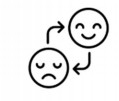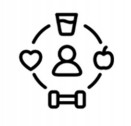The Neurourbanism Assessment (NUA) is a comprehensive methodology for urban wellbeing, designed for the in-situ evaluation of urban interventions' impacts on the mental health status at the neighborhood scale. Unlike traditional clinical assessments focusing on individuals, NUA is centered on the "diagnosis of the space," seeking to understand how the human nervous system collectively responds to its urban surroundings so they can be optimized for mental health promotion. NUA ensures ecological validity by collecting multi-modal data in real-world urban environments, avoiding artificial laboratory simulations. Additionally, as a bottom-up citizen's sience approach it engages community members themselves in the collection of data to informs the urban planning and design.
NUA Building Blocks: Multi-Modal Data Collection
- Objective Neuro-physiological Measures captured by recording the electrical byproducts of neural and bodily activities - the brain and body state of residents as they explore urban spaces. They include the inputs from Mobile Electroencephalography (mEEG): Participants wear portable, non-invasive (such as the Muse 2 headband), to measure brain activity oscillations. Biomarkers such as Alpha (8-13Hz) and Beta (14-30 Hz) Oscillations as well as the Heart Rate Variability (HRV) are taken under consideraton.
- Subjective, Self-reported Measures: Mental Health Metrics: Standardized questionnaires measure stress (PSS-10), generalized anxiety (GAD-7), and depressive symptoms (PHQ-8), Quality of Life and Community wellbeing measured with WHOQoL-BREF), and contextual data regarding momentary mood, sleep quality and recording experience.
- Spatial and Environmental Measures: Metrics include canopy cover area, permeable surface ratio, noise levels, thermal comfort, and air quality (e.g., µg/m³ of NO2 or PM2.5). Moreover, the Contemplative Landscape Model (CLM) score is used for expert assessment of landscape visual quality, urban morphology, topography, composition, and aesthetics.
The NUA relies on a citizen science approach, actively engaging residents as participants to collect their own mental health data. The assessment follows a structured seven-day protocol:
- . Enrolment Day (1–1.5 hours): Participants are registered for NUA study (receiving a unique participant code for anonymization), and receive training on the use of the mEEG device and the associated smartphone applications. An initial on-site recording is performed, followed by self-report measures. They also answer wellbeing questionnaires in the end.
- Autonomous Recording (5 days): Participants take the device home and perform three recording sessions on their own (one on-site walk, two at home during daily activities), each including a 1-minute rest period and a 20-minute activity period. Daily short-term mood questionnaires are also completed.
- Closing Day: Participants return the device, complete final reports, and receive compensation for their time.









NUA-Index
The primary quantitative output of the NUA is the NUA-Index, which translates complex neuro-psychophysiological and environmental data into a unified, meaningful metric. It is presented as a numeric score expressed as a percentage and it provides an aggregated measure of a neighborhood’s overall mental wellbeing status as influenced by its environment.
NUA Index is a combination of five sub-indices - dimensions related to five distinct categories of urban mental health. It allows for comparison of different places beween each other and also comparison following urban interventions (e.g., park transformation), enabling continuous health and wellbeing monitoring and quantifying tangible improvements in neighbourhood wellbeing metrics.

Neurophysiology: Objective data derived from mobile EEG (mEEG) and Heart Rate (HR), reflecting objective states such as stress, relaxation, alertness, and engagement during passive exposure to environments.

Wellbeing: Subjective metrics gathered from questionnaires focused on mental health (stress, anxiety, depression).

Community Bonding: Measures related to the residents' sense of place and connection within the neighborhood.

Lifestyle: Self-reported data on behaviors such as screen time, sleep quality, and time spent outdoors.

Objective spatial and environmental data, including canopy cover area, noise levels, air quality, permeable surface ratio, and results from the Contemplative Landscape Model (CLM) assessment.
